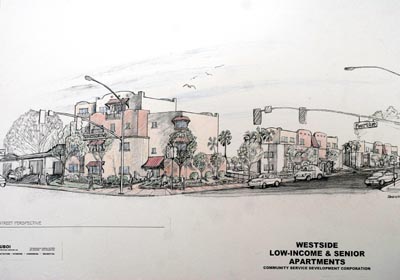
A long-considered low-income housing proposal on the west side
has hit a funding roadblock with council members at last week’s
meeting
– acting as the Redevelopment Agency Board – indicating the city
would not lend the $7.4 million needed to build it. The Westside
Apartments project, a 32-unit, five-building venture near the
intersection of Westside Boulevard and Fourth Street, will be put
on hold until further funding can be s
ecured.
HOLLISTER
A long-considered low-income housing proposal on the west side has hit a funding roadblock with council members at last week’s meeting – acting as the Redevelopment Agency Board – indicating the city would not lend the $7.4 million needed to build it.
The Westside Apartments project, a 32-unit, five-building venture near the intersection of Westside Boulevard and Fourth Street, will be put on hold until further funding can be secured.
The RDA has an estimated $8.8 million in other housing projects scheduled for this fiscal year. The beginning fund balance for housing is $12 million with an estimated ending balance of $3.2 million. These ending amounts can change if there are requests for additional funds that are approved by the redevelopment board – council members – or if new projects arise that are backed by officials.
The project developer, Community Service Development Corp. of San Benito County, and architect David Huboi both presented the proposal to the board in an information-only setting with no vote. Huboi said he believes the city “wants” the Westside apartments.
“I left thinking that everyone wants that project,” said Huboi, who has been working with the RDA on this project for more than nine years. “I know how important it is to the city.”
One concern for Councilwoman Pauline Valdivia is cost. The project, which has a total cost of $8.9 million, already has a $1.5 million commitment from the developer. She did note that the longer the project is put off, the more money it will cost in the end.
“There is a concern about the how the project is going to be costly. It’s not like we have to do something to make a profit – that’s not what the funds are for.”
City Councilman Doug Emerson pointed out the apartments will come to $270,000 per unit, which would include the cost of the land. While he said it is “an attractive building that we need in that end of town,” he said, “that’s an awful lot of funding for an apartment.”
Emerson said although he could only speak for himself, he thought council members were in agreement to have the developer find different funding avenues for the project.
“There’s no way I could justify a $270,000 per unit contribution,” said Emerson.
Valdivia still believes council members cannot “let this go.”
“It’s going to provide housing for the folks and the community that need them desperately,” she said.
The project will also feature a wide variety of bedrooms per unit. Huboi said many of the units for families would include three to four bedrooms. One of the buildings would be four stories tall and would house elderly tenants. For those elderly units, most would have just one bedroom or it would be a studio apartment.
The buildings and apartments would be built using “build it green” standards and will be less expensive for residents because of the techniques used.
“It will have a diverse offering to the community in terms of bedrooms,” he said.
The project, if approved, would bring in a net revenue of $1 million per year for the city. Using those funds, it would take the city take more than seven years to recoup the initial funding for the project, Emerson said. He said the city needs more efficiency in affordable housing.
“We need a more efficient way of providing affordable housing,” Emerson said. “It’s a beautiful project. It fits right in. The cost is not justifiable.”
South County Housing actually has two projects planned for the future, both of which have a per-unit cost of about $50,000, Emerson noted.
RDA Projects Manager Bill Chow had similar thoughts about the project such as its “great location.” In early 2000, the RDA kicked off the process by providing a land acquisition loan of $1 million, Chow said.
“Everyone thought the project was a good project in the west gateway,” he said. “Staff liked the concept – the location is a great location. The staff’s only concern was the funding.”
Although the RDA wasn’t willing to give the developers the entire $7.4 million for the project, the board did give direction to staff to help the developer apply for additional funds. Chow said one possibility is that the money could come from federal home funds.
“It could pass, but I think there is some discussion that RDA staff should work with CSDC to see if we can help them get additional funds to meet their financial gap.”
He added that it does make sense to have the apartments be classified as high density because of the proximity or shopping and medical care.
The next time the developer could apply for funding is in a year, Chow said.
“No timeline was given and staff was given direction to help them secure different funding sources.”
The benefits for the city do not include just housing for low income families but also funds from construction.
“It will bring in about $12 million in construction costs,” Chow said. “It will definitely bring in money to the city. It’s definitely a good project but they are asking for a bit too much at this time.”








